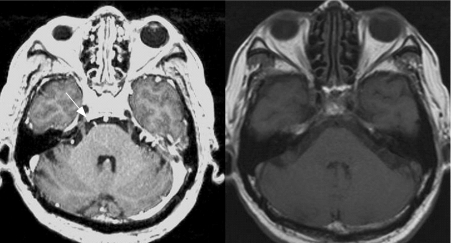Interferons (IFNs) and their pegylated forms (PEG‐IFNs) are widely used in the treatment of viral hepatitis and some neoplasms. Although ophthalmic symptoms are common among their various side effects,1,2 abducens palsy is rarely observed. Here, we describe a case where abducens palsy developed during PEG‐IFN therapy, and discuss the management.
Case report
A 65‐year‐old man had undergone removal of stage IV renal cell carcinoma 5 years ago. He had been managed with IFNα therapy (6×106 IU three times a week) for recurrence. Although the therapy suppressed tumour growth effectively, it had moderate side effects including influenza‐like symptoms, erythema and depression. After 4 years of conventional IFN therapy, PEG‐IFNα became available for the patient.
On the first day of PEG‐IFN therapy (3×106 IU), the patient had the expected fever and malaise. The next day he developed diplopia, which worsened gradually. After 1 week, the patient was referred to ophthalmologists and was diagnosed as having right abducens palsy (fig 1, upper panel). IFN‐induced retinopathy was absent. Diabetes mellitus was negative with fasting glucose (73 mg/dl) and haemoglobin A1c (5.5%). He did not have hypertension. MRI showed no evidence of metastasis or intracranial hypertension, but showed enhancement of the right abducens nerve (fig 2).
Figure 1 Upper panel: detail of the patient, primary position and lateral gaze at the initial examination. Note that abduction of his right eye is limited. Lower panel: eye position of the patient 5 months after the onset of symptoms. Abducens palsy resolved completely and the diplopia disappeared. Informed consent was obtained for the publication of this figure.
Figure 2 MRI scans of the axial section of the patient's brain. Magnetisation‐prepared rapid gradient echo images (left) show the enhancement of right sixth nerve (arrow). An unmodified plain T1 image is also shown (right).
After 1 month of onset of diplopia, painful swelling of the right parotid gland was noted. In another 1 month, dry eye and dry mouth sensations developed. The result of Schirmer's test (3 mm) and fluorescent corneal staining suggested presumable Sjögren's syndrome (SS). Furthermore, serum examination showed increased SS A and SS B antibody levels (128 and 23.2 U/ml, respectively) and antinuclear antibody with speckled pattern. Other autoantibodies and cryoglobulinaemia were absent. Although lymphocytic sialoadenitis in salivary glands did not fulfil the focus score criteria, he was diagnosed as having primary SS by the revised European–American classification criteria.3
Considering the poor prognosis of the carcinoma and lack of alternative treatments, the patient returned to conventional IFN therapy. He did not receive steroids. His diplopia improved gradually and resolved in 5 months (fig 1, lower panel).
Comment
The patient presented abducens palsy soon after the initiation of PEG‐IFN therapy. Two similar cases have been described to date.4,5 CT or unenhanced MRI were performed, which failed to detect an abnormality. Both cases recovered completely, with steroid use in one case. The mechanism by which IFN induces abducens palsy is unclear.
The enhancement of the abducens nerve is seen in disseminated tumour, inflammation, trauma, venous congestion or autoimmune disease, but less likely in diabetic microinfarcts.6 We assume that the IFN‐activated immune system induced an acute inflammatory process in the abducens nerve, which appeared as the enhancement, and led to ensuing development of SS. In fact, IFNs have complex immunomodulating effects and frequently induce or exacerbate autoimmune disease.7,8
The symptom resolved spontaneously as abducens palsy usually does. The cessation of IFN and/or the use of steroids may not be necessary for such patients. Careful monitoring enabled us to detect SS. Searching for autoimmune disease might be considered when faced with unexplained symptoms during IFN therapy. Unrecognised autoimmune diseases may affect the therapeutic course.
Footnotes
Competing interests: None.
Informed consent was obtained for the publication of the person's details in this report.
References
- 1.Sleijfer S, Bannink M, Van Gool A R.et al Side effects of interferon‐alpha therapy. Pharm World Sci 200527423–431. [DOI] [PubMed] [Google Scholar]
- 2.d'Alteroche L, Majzoub S, Lecuyer A I.et al Ophthalmologic side effects during alpha‐interferon therapy for viral hepatitis. J Hepatol 20064456–61. [DOI] [PubMed] [Google Scholar]
- 3.Vitali C, Bombardieri S, Jonsson R.et al Classification criteria for Sjogren's syndrome: a revised version of the European criteria proposed by the American‐European Consensus Group. Ann Rheum Dis 200261554–558. [DOI] [PMC free article] [PubMed] [Google Scholar]
- 4.Fukumoto Y, Shigemitsu T, Kajii N.et al Abducent nerve paralysis during interferon alpha‐2a therapy in a case of chronic active hepatitis C. Intern Med 199433637–640. [DOI] [PubMed] [Google Scholar]
- 5.Hosogi M, Hasebe S, Matsuo T.et al Abducens nerve palsy in a case under treatment with systemic interferon. Rinsho Ganka 1997511357–1360. [Google Scholar]
- 6.Hosoya T, Adachi M, Yamaguchi K.et al Abducens nerve enhancement demonstrated by multiplanar reconstruction of contrast‐enhanced three‐dimensional MRI. Neuroradiology 200143295–301. [DOI] [PubMed] [Google Scholar]
- 7.Dumoulin F L, Leifeld L, Sauerbruch T.et al Autoimmunity induced by interferon‐alpha therapy for chronic viral hepatitis. Biomed Pharmacother 199953242–254. [DOI] [PubMed] [Google Scholar]
- 8.Oishi A, Miyamoto K, Kashii S.et al Retinopathy is not the only ocular symptom: myasthenia gravis in association with interferon therapy. Br J Ophthalmol 2005891542–1543. [DOI] [PMC free article] [PubMed] [Google Scholar]




